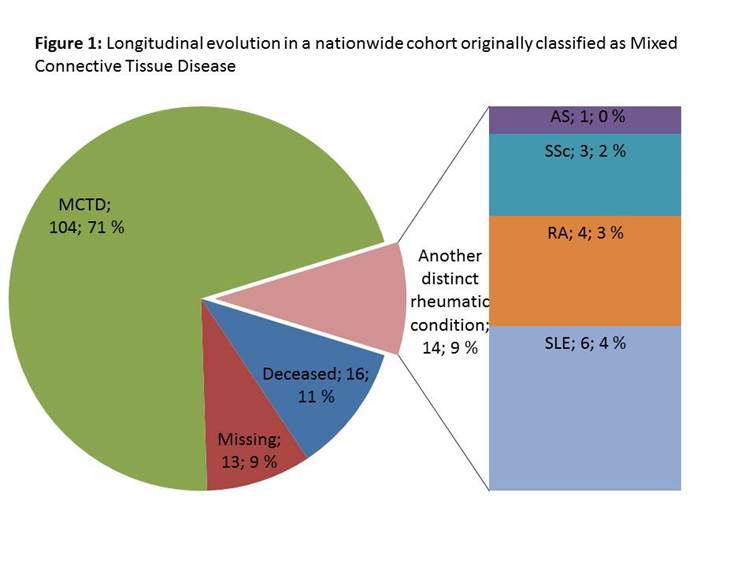Session Information
Date: Monday, November 6, 2017
Title: Systemic Lupus Erythematosus – Clinical Aspects and Treatment Poster II: Damage and Comorbidities
Session Type: ACR Poster Session B
Session Time: 9:00AM-11:00AM
Background/Purpose: Ever since Mixed Connective Tissue Disease was presented as a distinct entity in 1972, it has been discussed whether MCTD represents an undifferentiated, transient or stable phenotype. Previous studies have been inconclusive regarding frequency of diagnostic converters (i.e. cases evolving from MCTD to another well-defined rheumatic disorder) potentially causing different research cohorts of SLE and SSc. The aims of this study were to evaluate the prevalence of MCTD patients evolving into another well-defined rheumatic disorder, and to assess the disease activity and prevalence of remission in MCTD patients after long term follow-up.
Methods: 118 patients were included from the Norwegian MCTD cohort. Patients were defined as having evolved from MCTD if the antibody profile together with the clinical features were compliant with another well-defined rheumatic disorder. Remission was defined by the combined presence of SLEDAI equal zero and EUSTAR less than 2.5. Possible predictors of stable phenotype and remission were assessed by logistic regression.
Results: The mean (SD) time between study inclusion and follow-up was 7 (2) years. 9 % of the MCTD patients had evolved into another specific rheumatic disorder (6 SLE, 4 RA, 3 SSc and 1 ASA, Fig. 1). The presence of puffy hands before or at study inclusion predicted a stable MCTD phenotype at follow-up in univariate regression analysis (OR: 6.5, CI: 1.6 -27.1, P=.010). SLEDAI-2K scores were found to decrease over time and over 90% of patients had EUSTAR index activity < 2.5. The prevalence of remission was 28 % at inclusion and 46 % at follow-up. 30 % were in remission during the observational period and at follow-up (extended remission) and 13 % of patients were in remission at inclusion, during the observational period and at follow-up (durable remission, Fig. 2). One of the strongest predictors of remission was increasing FVC % pred at inclusion (Table 1).
Conclusion: Our results strengthen the view of MCTD as a distinct rheumatic condition as only a small proportion of patients evolved into another well-defined rheumatic disorder. Durable remission in MCTD is infrequent, however the SLEDAI-2K scores and EUSTAR activity index demonstrate that MCTD patients appear to have milder disease activity than SLE and SSc patients.
To cite this abstract in AMA style:
Reiseter S, Gunnarsson R, Corander J, Haydon J, Lund MB, Molberg Ø. Longitudinal Evolution in a Nationwide Cohort Originally Classified As Mixed Connective Tissue Disease [abstract]. Arthritis Rheumatol. 2017; 69 (suppl 10). https://acrabstracts.org/abstract/longitudinal-evolution-in-a-nationwide-cohort-originally-classified-as-mixed-connective-tissue-disease/. Accessed .« Back to 2017 ACR/ARHP Annual Meeting
ACR Meeting Abstracts - https://acrabstracts.org/abstract/longitudinal-evolution-in-a-nationwide-cohort-originally-classified-as-mixed-connective-tissue-disease/



